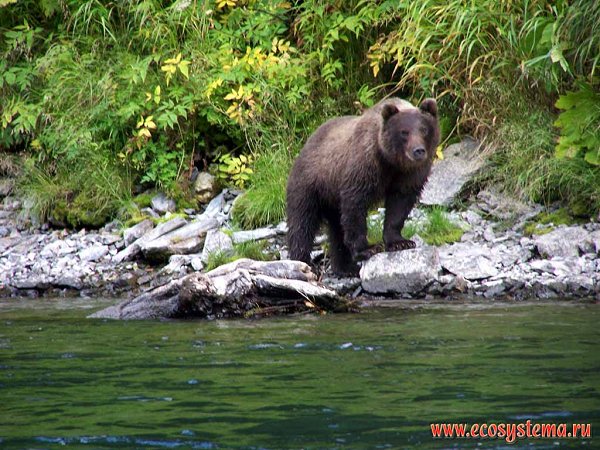 ©
www.ecosystema.ru/
©
www.ecosystema.ru/
The Kamchatkan Brown Bear ( Ursus arctos ) is a species of bear that
can reach masses of 130–700 kg (300–1500 pounds ).
The Grizzly Bear ( Ursus arctos horribilis ), the Kodiak Bear and
the Mexican Brown Bear are North American subspecies
of the Brown Bear. It is sometimes referred to poetically as the bruin.
Brown Bears have furry coats in shades of blonde, brown, black,
or a combination of those colors;
the long outer guard hairs are often tipped with white or silver,
giving a "grizzled" appearance.
Brown bears have a large hump of muscle over their shoulders, giving
strength to the forelimbs for digging.
Their forearms end in massive paws tipped with extremely powerful
claws that can be up to 15 cm (5.9 inches ) in length.

Photo: nai.arc.nasa.gov/kamchatka
(notactive as per Sept. 2010)
Unlike the claws of other large predatory animals, such as
lions or tigers, the claws are not retractable.
This gives the claws a dull edge when compared to other predators.
Despite the relatively dull edges to their claws, the sheer force
of a blow from a large specimen is devastating.
However, these claws are mainly used for digging, not for hunting.
It uses its sharp canine teeth for neck-biting its prey when hunting.
Bears use the same technique as tigers when hunting: they ambush
their prey.
Their heads are large and round with a concave facial profile.
In spite of their size, some have been clocked at speeds in excess
of 56 km/h (35 mph).
Along with their strength and deceptive speed, Brown Bears are legendary
for their physical stamina.
They are capable of running at full speed for miles at a time without
stopping.

Brown
bear (Ursus arctos arctos) running. From Skandinavisk Dyrepark,
Denmark
Photo: ©
Malene Thyssen Wikimedia
The Brown Bear is primarily nocturnal and, in the summer, puts on
up to 180 kg (400 pounds) of fat ,
on which it relies to make it through winter, when it becomes very
lethargic.
Although they are not true hibernators and can be woken easily,
they like to den in a protected spot such as a cave ,
crevice, or hollow log during the winter months.

© -
josef hlasek
They are omnivores and feed on a variety of plant parts, including
berries, roots , and sprouts ; fungi ;
and fish , insects , and small mammals .
Contrary to popular mythology, Brown Bears are not particularly
carnivorous;
they derive up to three-quarters of their dietary food energy from
vegetable matter.

© -
josef hlasek
Normally a solitary animal, the Brown Bear congregates alongside
streams and rivers during the salmon spawn in the fall.
Every other year females produce one to four young, which weigh
only about 1 to 2 kg (2 to 5 lb) at birth
Another source says from only 300 gr to 600 gr. But that won't last
long..

© -
josef hlasek
Raised entirely by their mother, the cubs are taught to climb trees
at the sign of danger.

© -
lubomir hlasek
text nai.arc.nasa.gov/kamchatka
sew also
Brownbear
in Kamchatka
American black bear - more to come
 For
250 other animals - click here
For
250 other animals - click here















